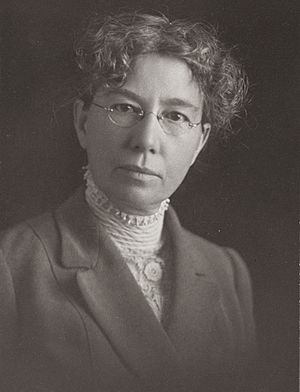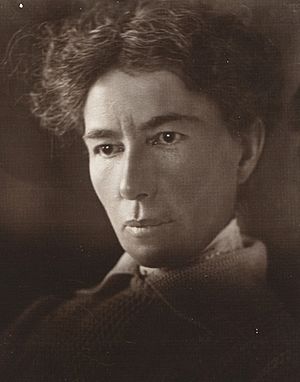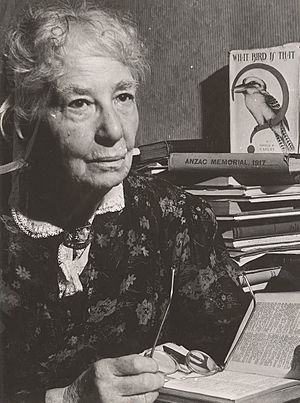Mary Gilmore facts for kids
Quick facts for kids
Mary Gilmore
|
|
|---|---|

Gilmore in 1916, by May Moore
|
|
| Born |
Mary Jean Cameron
16 August 1865 near Crookwell, New South Wales, Australia
|
| Died | 3 December 1962 (aged 97) Sydney, New South Wales, Australia
|
| Occupation | Writer |
| Spouse(s) | William Alexander Gilmore |
| Children | 1 |
Dame Mary Jean Gilmore (born Mary Jean Cameron; August 16, 1865 – December 3, 1962) was a famous Australian writer and journalist. She wrote many poems and stories, making a big impact on Australian literature.
Mary Gilmore was born in the countryside of New South Wales. She spent her childhood in places like the Riverina area, living in small country towns and bigger ones like Wagga Wagga. At 16, she became a schoolteacher. After teaching in the country, she moved to Sydney.
In Sydney, Mary became involved with the growing labour movement, which worked to improve conditions for workers. She also followed the ideas of utopian socialism from William Lane, who believed in creating perfect communities. In 1893, Mary and about 200 others joined Lane in Paraguay to start a new community called the New Australia Colony. She began her family there, but the colony didn't work out as planned. She returned to Australia in 1902.
Back in Sydney, Mary used her connections to find work at The Australian Worker newspaper. She became the editor of the women's section, a job she held from 1908 to 1931. She also wrote for other newspapers like The Bulletin and The Sydney Morning Herald. She became known for fighting for the rights of people who were struggling.
Mary's first book of poems came out in 1910. She wrote many more books throughout her life, mostly poetry, but also memoirs and essays. She wrote about many different topics, but people especially loved her vivid descriptions of country life. Her most famous poem is "No Foe Shall Gather Our Harvest", which helped boost spirits during World War II.
Mary Gilmore received her greatest recognition later in life. She was a respected figure in Sydney's writing community and became a national hero. She often appeared on radio and television. Mary kept writing a lot even when she was old. Her last book of poems was published in 1954 when she was 89. Two years before that, she started writing a new column for the Tribune newspaper, which she continued for almost ten years. Mary Gilmore died at 97 and was given a state funeral, a very special honour for a writer. Since 1993, her picture has been on the back of the Australian ten-dollar note.
Growing Up
Mary Jean Cameron was born on August 16, 1865, in a small place called Cotta Walla (now Roslyn), near Crookwell, New South Wales. When she was one year old, her parents, Donald Cameron (a farmer from Scotland) and Mary Ann Beattie, moved to Wagga Wagga. They wanted to be closer to her mother's parents, the Beatties.
Her father got a job managing a farm at Cowabbie, about 100 kilometers north of Wagga. A year later, he became a carpenter. For the next 10 years, he built houses on farms in areas like Wagga, Coolamon, Junee, Temora, and West Wyalong. Because her family moved around a lot, Mary's schooling was not always regular. However, she did get some education during their frequent visits to Wagga, where they stayed with her grandparents or in rented homes.
Her father eventually bought land and built their own house at Brucedale, near Junee Road. This gave them a permanent home. Mary then briefly attended Colin Pentland's private Academy in North Wagga Wagga. When that school closed, she moved to Wagga Wagga Public School for two and a half years. At 14, she worked as an assistant at her uncle's school in Yerong Creek to prepare for becoming a teacher. Another uncle, Charles White, was a journalist and wrote books about bushrangers (Australian outlaws).
After passing her teaching exams in 1882, she became a teacher at Wagga Wagga Public School until December 1885. After a short time teaching at Illabo, she took a job at Silverton, near the mining town of Broken Hill. It was there that Mary Gilmore developed her ideas about socialism and began writing poetry.
Becoming a Writer
In 1890, Mary moved to Sydney. There, she became part of a group of radical writers known as the "Bulletin school." While Henry Lawson greatly influenced her work, it was Alfred "A. G." Stephens, the literary editor of The Bulletin, who published her poems. This helped her become known as a strong, radical poet who spoke up for workers and those who were treated unfairly.
She had a relationship with Henry Lawson, which likely started in 1890. She wrote about an unofficial engagement and Lawson's wish to marry her. However, their relationship ended because he was often away from Sydney. The story of their relationship is told in a play called "All My Love" by Anne Brooksbank.
In 1896, she followed William Lane and other socialist thinkers to Paraguay. They had started a community called New Australia there two years earlier. At Lane's new settlement, Cosme, she married William Gilmore in 1897. By 1900, it was clear the socialist experiment had failed. Will left to work as a shearer in Argentina. Mary and her two-year-old son, Billy, soon followed. They lived separately in Buenos Aires for about six months. Then the family moved to Patagonia until they saved enough money to return to Australia in 1902, by way of England. They then started farming near Casterton, Victoria.
Mary Gilmore's first book of poems was published in 1910. For the next 50 years, she was considered one of Australia's most popular poets. In 1908, she became the women's editor of The Worker, the newspaper of the Australian Workers' Union (AWU). This was Australia's largest and most powerful trade union at the time. She was the union's first woman member. The Worker gave her a platform for her journalism. Through her writing, she campaigned for better working conditions for women, for children's welfare, and for a better deal for indigenous Australians.
Her Later Years
By 1931, Mary Gilmore's views had become too strong for the AWU. However, she soon found other places to publish her writing. She later wrote a regular column for the Communist Party's newspaper Tribune, even though she was never a member of the party herself. Despite her somewhat strong political views, Mary Gilmore accepted an award in 1937. She became a Dame Commander of the Order of the British Empire, which meant she was known as Dame Mary Gilmore. She was the first person to receive this award for her contributions to literature. During World War II, she wrote inspiring patriotic poems like No Foe Shall Gather Our Harvest.
In her later years, Mary Gilmore separated from her husband and moved to Sydney. She enjoyed her growing fame as a national literary icon. Before 1940, she published six books of poetry and three books of prose (stories and essays). After the war, Mary published memoirs and memories of early Australia and the famous writers of Sydney in the 1890s. This helped to create many stories and legends about that time. Dame Mary Gilmore died in 1962, at the age of 97. She was given the first state funeral for a writer since Henry Lawson died in 1922.
Recognition and Legacy
Mary Gilmore's picture is on the current Australian $10 note. The note also features an image inspired by her poem No Foe Shall Gather Our Harvest. As a security feature, the text of the poem itself is printed in tiny letters. The background of the image includes a portrait of Gilmore by the famous Australian artist Sir William Dobell.
Dobell's 1957 portrait of Dame Mary Gilmore was a finalist for the Archibald Prize that year. You can see it in the Art Gallery of NSW.
In 1973, she was honored on a postage stamp issued by Australia Post.
Several places are named after her. These include the Canberra suburb of Gilmore, the state highway called Mary Gilmore Way, a federal voting area called the Division of Gilmore, and Gilmore Crescent in the Canberra suburb of Garran.
She was the great-great aunt of future prime minister Scott Morrison. In 2012, on the 50th anniversary of her death, he gave a speech in federal parliament honoring her. In September 2019, Mary Gilmore's poem, "No Foe Shall Gather Our Harvest," was read aloud by United States president Donald Trump during a state dinner for Australia, with Prime Minister Morrison present.
See also
 In Spanish: Mary Gilmore para niños
In Spanish: Mary Gilmore para niños



